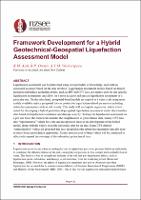| dc.description.abstract | Liquefaction assessment can be performed using various bodies of knowledge, each with an associated accuracy based on the data involved. Liquefaction assessment models based on directly measured subsurface geotechnical data, such as SPT and CPT data, are mainly used for site-specific liquefaction assessments and allow for a more accurate and precise liquefaction assessment of a particular site. On the other hand, geospatial-based models are applied at a wider scale using more readily available surface geospatial data as proxies for liquefaction-related parameters including subsurface parameters such as soil density. This study will use logistic regression, which is best suited for developing a hybrid geotechnical-geospatial liquefaction assessment model that classifies sites based on liquefaction occurrence and damage severity. To keep the liquefaction assessment on a per-site basis, the framework includes the simplification of geotechnical data, mainly CPT data, into “representative” values for a site and incorporates these in the development of the hybrid model, along with the widely available geospatial data for an area. Some CPT-derived “representative” values are proposed that may encapsulate the subsurface quantities typically used in stress-based geotechnical approaches. Spatial interpolation of these values will be conducted to effectively expand the coverage of the subsurface geotechnical data. | |

